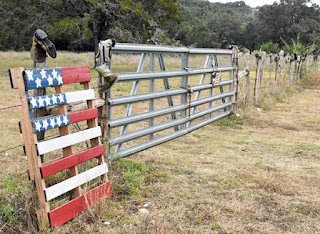One of the reasons I so like road trips is that you never can tell what you might find just over the next hill. On a recent trip, just meandering around the central Texas Hill Country on Highway 39 near the town of Hunt, I came across "Boot Hill." Not on any map and down a narrow, twisting 2-lane blacktop road in the middle of nowhere, I almost drove right past it before thinking, "What the heck is that?" I pulled off to the side of the road (no worries as there was nobody else on the road) to take pictures and investigate.
It seems the "Boot Hill" fence got its start in the early 1970's when a family with six kids began mounting their children's worn-out boots on the wooden fence posts of their friend and neighbor's property. The neighbor, John Jobes, thought it was kind of funny so he started putting his two daughter's outgrown boots on the posts as well. Then the ranch hands began putting up their boots and before long, it became the final resting place for other folk's boots. Now, the boots are on every post for a lengthy distance and have even jumped across the road.
It's not exactly uncommon for people to put all sorts of mementos out on a fence for the pleasure of gawking passerby's. There is a stretch of road near Placerville, California which has shoes of all kind placed on fence posts and another place in Minnesota where people placed their old sneakers on posts. There's even a lengthy section of road in New Zealand which has become widely known as the Cadrona Bra Fence, but you can't get more pure Texas than this stretch of road known as Boot Hill.
It seems the "Boot Hill" fence got its start in the early 1970's when a family with six kids began mounting their children's worn-out boots on the wooden fence posts of their friend and neighbor's property. The neighbor, John Jobes, thought it was kind of funny so he started putting his two daughter's outgrown boots on the posts as well. Then the ranch hands began putting up their boots and before long, it became the final resting place for other folk's boots. Now, the boots are on every post for a lengthy distance and have even jumped across the road.
It's not exactly uncommon for people to put all sorts of mementos out on a fence for the pleasure of gawking passerby's. There is a stretch of road near Placerville, California which has shoes of all kind placed on fence posts and another place in Minnesota where people placed their old sneakers on posts. There's even a lengthy section of road in New Zealand which has become widely known as the Cadrona Bra Fence, but you can't get more pure Texas than this stretch of road known as Boot Hill.


















































